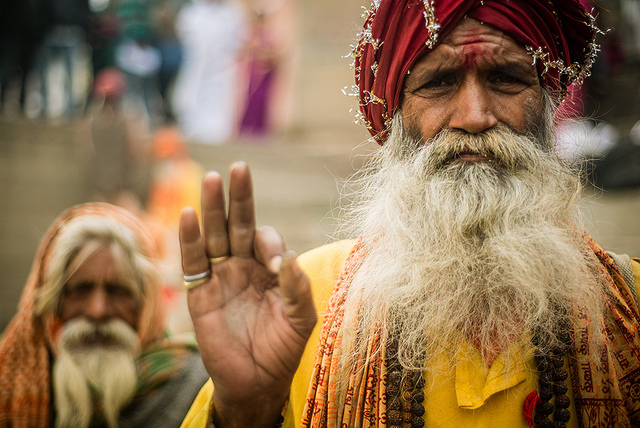I didn’t go looking for meditation, not consciously at least. Past imprints on the soul work according to their own rhythms and dictates. I grew up in Hong Kong, and as a senior in high school saw an exhibit of black-and-white photographs by Chris Rainier. As I walked through the gallery, I was mesmerized by the images of yogis and sadhus on the banks of the Ganges River in Benares, India, one of the holiest and oldest continuously inhabited cities on the planet. I was deeply moved by Rainier’s pictures of exotic faces adorned with strange symbols, hair matted with cow dung, naked bodies smeared in cremation ash, and eyes in deep absorption.
I was drawn to one photograph in particular—a yogi floating in the sacred river in full lotus posture, face up, basking in the sun. In that image I saw meditative tranquility, spiritual union, ecstatic bliss….These words are all part of my lexicon now, but back then, I was struck speechless. The people in these pictures represented a different way of life, one that seemed foreign and mysterious to my mind, but felt like home to my soul. I vowed to go to Benares to encounter these yogis myself.
That opportunity came when I was twenty years old. I read a hot-off-the-presses copy of Dr. Mark Epstein’s Thoughts Without a Thinker in college and devised an independent study project on Buddhism and psychology. My fieldwork took me to a Buddhist monastery in Bodh Gaya, the site of Buddha’s enlightenment, a few hours from Benares. Reading Epstein’s book, studying with the monks in the monastery, and meditating daily all provided me with an opportunity for self-reflection and healing, to go deep into my mind beneath the waves of ordinary chatter, to confront the demons from childhood I had been unconsciously avoiding, to challenge my assumptions and cultural conditions, and to feel the intimations of a kind of self-acceptance my first teacher, Acharya Godwin Samararatne, called “true love.”
Those five months changed the entire direction of my life toward one of contemplation, toward one that valued being over doing, the inner world over the material world, and interconnectivity over the Western consumerist culture and reductionist science of my upbringing. I found the yogis on the Ganges—but more than discovering a spiritual path, practice, or teacher, I rediscovered fragmented parts of my self.
When I left India, I worked as an intern with Herbert Benson at his Institute for Mind Body Medicine at Harvard University, where he was doing clinical research on meditation. We taught patients with various medical issues how to meditate, and I learned how powerful and accessible an ancient technique could be for human beings raised in a modern culture so far removed from its own innate healing potential. Still, there was a stark contrast between this secularized, clinically applied meditation severed from its philosophical underpinnings and cultural trappings and the 2,500-year-old practice-in-context that I had been exposed to in India.
A few years later I would have an opportunity to resolve this dichotomy, at least for myself. When I was twenty-two years old, having returned from a second trip to India, I set about looking for an advisor for my master’s thesis on Buddhism and psychology. I approached Mark Epstein, whose writings had had such an impact on me. He was unavailable but kind enough to direct me to Dr. Joe Loizzo, a Harvard-trained psychiatrist and Columbia University-trained Buddhist scholar under Dr. Robert Thurman.
I first encountered Joe at Columbia Presbyterian Hospital in the psychiatry department where he was leading a group of patients in a Tibetan White Tara visualization. As I watched him guide patients through an advanced ancient meditation technique while maintaining the integrity of the tradition, I knew I had found someone very special. I have been working with him ever since. From our first encounter, Joe provided me with the human model of someone successfully straddling two worlds and the practical training for reproducing that success that has enabled me to become a Buddhist psychotherapist.
As a therapist, I don’t incorporate Buddhist meditation practices into a pre-existing Western paradigm as many of my colleagues do. Instead, I maintain the Buddhist worldview as my clinical frame of reference. Buddhist psychotherapy is a life education—or reeducation. It involves a realistic worldview based on interdependence, as well as mental training and recommendations for a harmonious lifestyle, each component working as an antidote to one of our three primary mental afflictions: misperception of separateness, emotional volatility, and maladaptive behaviors.
Because I believe the balance of secular and spiritual is so crucial, much of the teaching I do is as the Assistant Director of the Nalanda Institute for Contemplative Science in New York City, which Joe founded. Nalanda is a non-profit initiative designed to preserve the entire Indo-Tibetan Buddhist curriculum of contemplative life and education, making it accessible through the modern Western idiom of health psychology, depth psychotherapy, and neuroscience. Nalanda models itself on the original Nalanda University in India, one of the world’s first public institutions of higher learning and a repository of Buddhism dating back to the fifth century CE.
You can learn more about it at www.nalandascience.org.
Click here to find out about Rose’s thoughts on wellbeing and health



